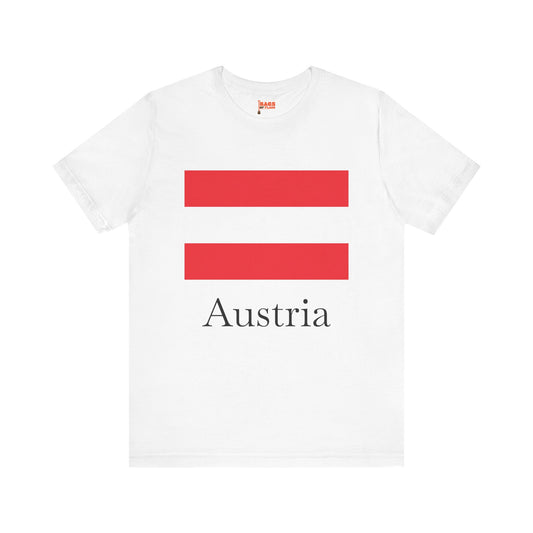-
Austria Leather Patch Hat
Regular price $18.85 USDRegular priceUnit price / per -
Austria Pillow
Regular price $22.65 USDRegular priceUnit price / per -
Austria Backpack
Regular price $59.79 USDRegular priceUnit price / per -
Austria Sweatshirt
Regular price $34.15 USDRegular priceUnit price / per -
Austria Flag Sweatshirt
Regular price $34.15 USDRegular priceUnit price / per -
Austria Mug
Regular price $11.65 USDRegular priceUnit price / per -
Austria Trucker Cap
Regular price $14.90 USDRegular priceUnit price / per -
Austria Hoodies
Regular price $34.40 USDRegular priceUnit price / per -
Austria T-shirts
Regular price $22.79 USDRegular priceUnit price / per -
Austria Flag Hoodies
Regular price $34.40 USDRegular priceUnit price / per -
Austria Flag on T-shirt
Regular price $22.79 USDRegular priceUnit price / per
Collection: Austria
The Austrian flag, also known as the Flag of Austria, is a symbol of national pride and identity for the people of Austria. Its design and colors have a rich history that reflects the country's heritage and values. We will explore the Austrian flag's design, meaning, significance, historical context, and current relevance.
Overview of the Austrian Flag

At its core, the Austrian flag features a striking yet simple design composed of three equally sized horizontal stripes. The pattern alternates between red at the top and bottom, with a white stripe sandwiched in the middle. This distinctive tricolor scheme has deep roots in Austria's history, tracing back to the medieval Babenberg dynasty, which played a pivotal role in the region's development during the Middle Ages.
The flag's bold colors and straightforward design make it an emblem easily recognized globally. It symbolizes Austria's enduring heritage and the resilience of its people. The contrast of red and white provides the flag with visual impact and carries a weight of historical significance that has been preserved over the centuries. This iconic flag encapsulates the spirit of Austria, standing as a testament to the country's rich past and ongoing story on the world stage.
Historical Context of the Austrian Flag

The lineage of the Austrian flag's red and white stripes stretches back to a legendary origin story from the 12th century involving Duke Leopold V of Austria. According to folklore, Leopold's white battle dress was soaked with blood after a fierce battle during the Crusades, but when he removed his belt, the cloth beneath remained white. This striking contrast inspired the red-white-red triband that would symbolize the region.
While likely apocryphal, this anecdote underscores the deep historical roots and the enduring significance of the flag's colors to the Austrian identity. The official adoption of the current flag configuration occurred in 1918, marking a new chapter in Austrian history following the dissolution of the Austro-Hungarian Empire after World War I.
This event signified Austria's transition to an independent republic, and the flag thus embodies both a connection to its medieval heritage and a symbol of new beginnings. The flag has witnessed various iterations throughout its history and has been at the forefront of Austria's evolving political landscape. Despite these changes, the fundamental design has remained a constant emblem of Austrian sovereignty, bridging the nation's rich past with its present and future aspirations.
Symbolism Behind the Austrian Flag
The vivid red and pure white hues of the Austrian flag are deeply symbolic, carrying historic and representative meanings of the country's values. Traditionally, the red color is interpreted to stand for bravery and strength—a nod to the resilience and fighting spirit of the Austrian people through times of conflict. The white, in contrast, is symbolic of peace and honesty, reflecting Austria's aspirations for harmony both within its borders and in its international relations.
These colors pay homage to the nation's historical struggles and triumphs and symbolize unity among its people, suggesting a balance between courage in the face of adversity and the pursuit of peaceful resolutions. Additionally, the arrangement of colors in a triband pattern can represent the country's rich landscape, from the bloodshed in its past to the snow-capped Alps that crown its terrain. This layer of symbolism adds a profound depth to the flag, making it a national emblem and a narrative of Austria's enduring spirit and natural beauty.
Current Relevance of the Austrian Flag
Today, the Austrian flag maintains its prominent role in the fabric of national identity, actively displayed during significant public events, including state holidays, military commemorations, and sports competitions. Its presence in these contexts is a powerful symbol of unity, rallying the nation around shared values and collective memory. Beyond formal occasions, the flag is also a common sight at various civic and cultural gatherings, reflecting the pride Austrians hold for their country's heritage and achievements.
Despite its widespread acceptance and use, the flag's historical underpinnings have occasionally sparked debate. Discussions have surfaced concerning its associations with different periods in Austria's past, including moments of national triumph and times of conflict. These debates underscore the complexity of national symbols and their ability to evoke various interpretations and emotions. Moreover, the flag's use by certain political groups has prompted conversations about the importance of ensuring that national symbols remain emblematic of the country's unity rather than divisions.
Amid these discussions, the flag continues to be a central element in Austria's representation on the international stage, symbolizing the nation's sovereignty, its commitment to democratic values, and its place within the global community. As such, the Austrian flag marks the country's past and waves as a beacon of its current aspirations and future directions.
Additional Facts About the Austrian Flag
The handling and display of the Austrian flag are governed by a set of ceremonial rules to ensure its dignity is always preserved. One such protocol dictates that the flag should be displayed so it does not come into contact with the ground, emphasizing the respect and reverence it commands. Ceremonies involving the flag, such as raising and lowering it, are also conducted with solemnity to honor the nation's emblem.
The juxtaposition of the Austrian flag alongside the European Union flag at official events and public buildings is a testament to Austria's integration and active participation in the EU, reflecting the country's alignment with European values and unity. Interestingly, the design that defines the modern Austrian flag draws inspiration from the banner of the Austrian Empire, illustrating a continuity in national symbolism from 1804 to 1867.
This connection underscores the deep historical roots of the flag's aesthetic and its significance as a symbol of continuity amidst change. These protocols and historical tidbits underscore the flag's importance in Austrian national identity, highlighting how traditions and modernity intertwine in the representation and respect of the national flag.






















